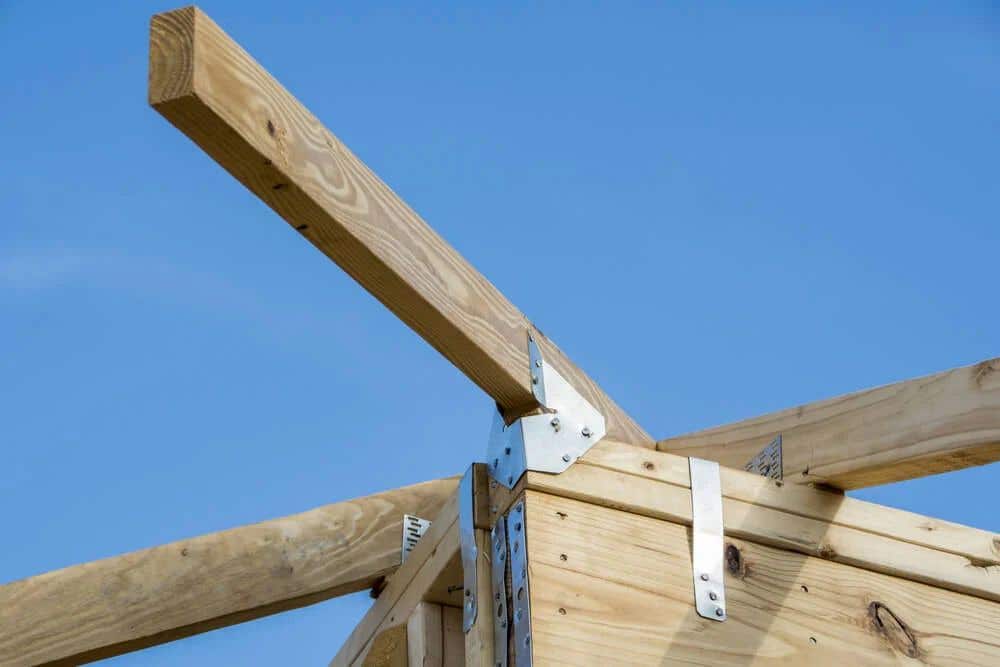If your Florida home was built before 2001, there’s a good chance your roof is missing a very important detail: a third nail in its metal hurricane truss straps. Homes built before the 2002 Florida Building Code took effect weren’t required to have this extra nail that makes the roof more resistant to hurricane winds.
What difference can a single nail make? For starters, it can upgrade your roof-to-wall attachment on your wind mitigation inspection from “toenails” to “clips.” That one change may help you save 20% to 50% on your home insurance.
What are hurricane clips?
Florida homes built after 2001 are required to have hurricane clips. These are steel connectors that attach your roof to your wall structure and are designed to withstand hurricane winds that hit your walls and put upward pressure on the overhang of your roof. In other words, they help keep the lid on.
In section four of your wind mitigation inspection, your connection may count as a clip if it’s secured to the truss/rafters with three nails.
Hurricane clips for rafters offer much more protection than “toenails” – the diagonal nails driven through the side of the roof truss into the top of the wall plate. This roof-to-wall attachment was popular in older homes, but it doesn’t provide much wind resistance for the roof.
The good news is that if you have toe-nail attachments, it may be easier to upgrade to hurricane clips than you might realize. It may just require an additional nail.
Hurricane clips vs straps
The terms “hurricane clips” and “hurricane straps” are often used interchangeably, and that’s usually accurate enough for most people. Hurricane clips may also be called:
- Hurricane ties.
- Hurricane strips.
- Hurricane anchors.
- Hurricane brackets.
That said, a hurricane clip usually describes a small bent steel plate that connects the roof of your home to wall trusses supporting it. Hurricane straps are more likely to be long, straight strips of metal or nylon.
Both hurricane clips and straps harden your home against wind damage, but it’s important to note that a Florida wind mitigation report specifically mentions clips. In fact, separates them into two categories: Metal connectors that do not wrap over trusses and rafters and those that do and are secured with three nails.
Are hurricane clips required in other states?
Because hurricane clips do a better job of protecting homes against hurricane-force winds, several Gulf States require them in new construction in addition to Florida.
- Alabama: Hurricane ties are required on all new homes, with no more than 30 nails used per tie. Only end trusses must be strapped, and two ties must be installed per door or window.
- Mississippi: All new homes must be built with four hurricane ties per window or door, and the ties must be able to withstand winds up to 110 mph.
- Louisiana: New homes must have hurricane ties and impact-resistant windows. Moreover, you’re required to hire a licensed contractor to install them or you may be fined.
- South Carolina: Hurricane straps are required on all new homes. If you’re planning to build, you need a licensed engineer to approve your straps.
How to update your roof-to-wall attachment from toenails to hurricane clips
Some companies, like LGT Restoration Services, Inc. and Maximum Solutions in Florida, specialize in retrofitting older homes to adhere to current wind mitigation standards. They offer easy updates from dual nail roof truss strap systems with a third nail.
Third Nail can work on most exteriors for hurricane strap retrofits, whether your home has aluminum, vinyl, metal, or wood siding. They specialize in servicing the southern half of Florida. Maximum Solutions operates throughout the state.
You want to make sure to use a company whose contractors are insured and licensed. That’s often the best way to make sure your roof-to-wall attachments are updated correctly so you can qualify for wind mitigation savings.
Several reputable companies throughout Florida offer this upgrade. When searching for other companies, do your research and make sure contractors are properly licensed.
How much does hurricane clip retrofitting cost?
Retrofitting costs for most homes range from $1,000 to $1,500, which includes a wind mitigation inspection (these usually cost about $100). Your exact cost depends on the company you use, whether the retrofit can be done in your attic, the retrofitting upgrade you choose, and your home’s square footage.
How much can you save with hurricane clips?
Upgrading your attachment from toenails to clips can help you save 20% to 50% on your yearly home insurance premium. All Florida home insurance companies are required to offer discounts for wind mitigation measures. However, the discount amount varies from company to company.
As a general rule, the more wind-resistant your home is, the less you’ll pay for your home insurance. You can learn more about how to make your home resistant to hurricane winds with our wind mitigation guide.
On average, Kin customers who upgrade from toenails to clips / singe-wraps save 37% on their premium – hundreds of dollars in savings each year.
Any time you make a change to your home you should think about upgrading your insurance, but that's especially true if you improve your wind mitigation. Get in touch with us today to see how much you’ll save on your home insurance with hurricane clips.


